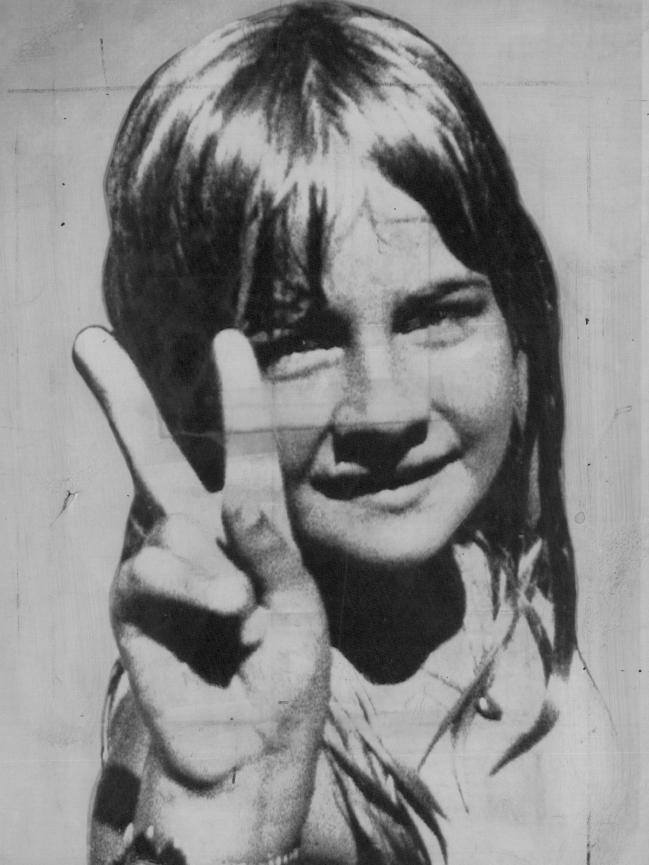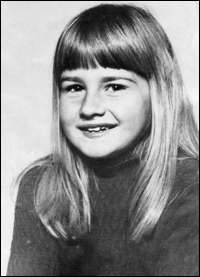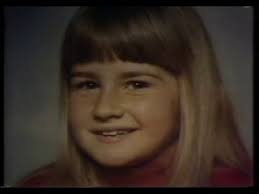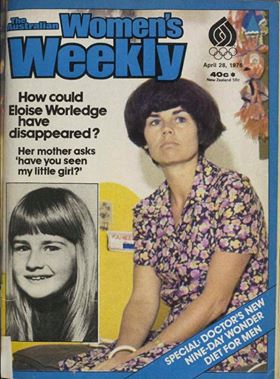



Last seen - at her home in Beaumaris, Victoria, January 12th/13th 1976
Circumstances of Disappearance
8 year old Eloise Worledge disappeared from her home in the Melbourne
suburb of Beaumaris, Victoria on January 12, 1976.
Her brother raised the alarm about her disappearance when he noticed she
was not in her room at 7.30am. He later told police he heard "robbers" who
kidnapped his sister, but was too scared to say anything at the time because he
thought they would take him too. There was no sign of a struggle.
Investigations revealed no signs of forced entry or a struggle. Police believed
Eloise was lured from her bed by someone she was familiar with and simply left
the house via the front door, which had been left unlocked. Another possibility
not discounted was Eloise may have been abducted by a prowler known to be in
the area at the time. A speeding car down the Worledge's street at 2am was reported
by a neighbour. Bark from a tree outside her window was found on her bedroom
floor. A small hole had been cut in the flyscreen in her window, but forensic
tests revealed it had been cut from the inside. Police believed it was too small
to have been used by the abductor. Because scientific evidence found it unlikely
that Eloise was taken through her open bedroom window, both parents were
initially treated as suspects.
Despite the biggest missing-person's search in Victoria's history and despite a
$10,000 reward posted in 1976 that remains unclaimed, no trace of her has ever
been found. Homicide cold-case detectives began reinvestigating the case in
2001.
Twenty-seven years after Eloise Worledge was snatched
from her bed in the dead of night, her mother yesterday said that the family
had long ago accepted the eight-year-old's disappearance as a mystery.
Speaking after coroner Frank Hender ruled it was impossible to identify who
was responsible for Eloise's disappearance, Patsy Worledge said the family
had "come to our own form of closure years ago".
Eloise Anne Worledge was taken from her home in Scott Street, Beaumaris, in
the early hours of January 12, 1976. A flywire screen on her wind-out window
was partially cut and rolled upwards and the window was fully open.
Her abduction sparked the biggest Victorian missing person's search in
history. Despite a recent 12-month re-investigation of new leads, a homicide
squad detective confirmed the case still baffled police.
Detective Senior Constable Robert Nazaretian told the Melbourne Coroners
Court that despite Eloise's father, Lindsay, being the prime suspect at the
time of her disappearance, a 2001 investigation found no evidence to
implicate either of Eloise's parents as the culprit. And new investigations
of known sex offenders, including a teacher and a librarian at Beaumaris
Primary School, failed to uncover any new evidence, he said.
Outside court, Ms Worledge said the family had been "devoted to learning
from our experiences, to healing and accepting the mystery"."And it is
indeed a mystery. And we don't actually need to know," she said.
Lindsay Worledge was not present at the hearing.
Senior Constable Nazaretian said evidence suggested someone had staged the
scene to look as if the flywire screen was cut from the inside to avert
suspicion from people connected to the Worledges.
The motivation to cut the screen from the inside by an intruder with no
connection to the household seemed inconceivable, he said. But entry, exit
or both was most probably made through the front door, which Ms Worledge
said she had left wide open, Senior Constable Nazaretian said.
The court heard that both Lindsay and Patsy Worledge had been having affairs
at the time and Mr Worledge was depressed about their looming separation. He
was to move out of the house the day Eloise went missing, a fact Senior
Constable Nazaretian described as "striking in its timing".
He said that in 2002 Ms Worledge told police that at the time of Eloise's
disappearance she believed Lindsay Worledge "was involved in the
disappearance as a means of prolonging the inevitable and as a way of
spiting her". Mr Worledge denied involvement in the abduction and a lie
detector test proved inconclusive, the court heard.
Convicted sex offenders interviewed when the case was reopened included a
teacher and a school librarian at Beaumaris Primary, as well as a man who
coached at the Beaumaris junior soccer club. But police could not uncover
any evidence of their involvement in Eloise's disappearance, or any evidence
linking sex killer Raymond "Mr Stinky" Edmunds to the crime.
Suspects at the time included Ms Worledge's two female friends and her
sister, Margaret Thomas, but a reinvestigation of their police interviews
found the links baseless.
Giving an open finding, Mr Hender said Eloise was a shy girl who would not
have voluntarily left home with a stranger. He said significant information
given to police included a neighbour's account of hearing a child cry out
and a car door slam at 2am on the night of the disappearance.
"It is not possible on the evidence to find who were the person or persons
responsible or when and how Eloise met her demise but her disappearance and
presumed death remains suspicious," Mr Hender said.
For a woman who might easily live in the dark, Patsy Worledge instead chooses to live in the light – surrounded by bright colours.
She thinks that way, she dresses that way and she paints that way – celebrating life on canvas, and leaving the interpretation to others. Surrounded by her art works at an exhibition this weekend, Ms Worledge looks at the startling colours that define her creations – bright-eyed children, exotic animals, an abundance of flowers – and says the stories are in the eye of the beholder.
"The stories," she says, "can be created by anybody."
Ms Worledge's personal story is well known. In January 1976, her daughter Eloise, 8, vanished from the family home in Beaumaris and was never found. It was a tragedy that made Patsy Worledge a household name in one of the most publicised cases in Australian history.
Today, approaching her 72nd birthday, she has built another life – built on a spiritual journey that has taken her through immersion in Chinese meditation to encounters with Aboriginal elders and artists. Indigenous art informs her own work: the colours, the dot work, the elevation of the mysteries of life to the canvasses that clutter her home.
"I never really thought I was that good at it but people liked it so I just kept going. You have to keep changing because that's what your heart wants to do and your soul wants to do. I paint from the soul. I don't decide anything, it just happens," she says.
"I've never had any repressive feelings about art. I went to an exhibit recently and the paintings were so boring you wouldn't believe it – pale colours, pale apricots and greens – I couldn't see what it was all about."
Ms Worledge has been painting since childhood, encouraged by her father. "I just used to draw and paint all the time." She stopped for a time in the 1970s, but returned to it a decade later, and has experimented with different styles ever since.
"I used to be a spiritual painter – it was about totally not knowing what you were going to paint – you don't have any mind in it. Jars of colours all around the table, water in the middle and the colour chooses you. The first time I sold a painting I was doing watercolours … I sold them all. It makes your heart sing, and that's what I'm here for."
Her current exhibition is the product of nearly 12 months of work, and features 38 paintings whose titles include We Will Recall The Things That Matter, Sense of Love and Wonder, Boundless Stories of Grace and Glad To Be Alive.
The lesson of her life, and of her art, is simple: there is always hope to be found, a light around the corner, the beauty of something simple like a flower to celebrate. Buoyant of personality and vibrant of appearance – she dresses in the colours that define her paintings – she admits it is not always easy for any of us to celebrate life.
"Sometimes you have to pretend," she says.
"But I don't pretend any more. Always have faith in yourself and what you do in yourself. You have to consolidate your feelings. Not bury them, understand them. I know how many people love me and lot of people don't have to say, it, I just know it.
"I think people would cross the road because they didn't know what to say to me. But I've I always had a lot of beautiful people with me and that's been a blessing."
* Patsy Worledge's exhibition All Creatures Great and Small is at the Beaumaris Art Group, Reserve Road, Beaumaris. More information beaumarisartgroup.org.au
The father of Eloise Worledge, the eight-year-old taken from her Beaumaris home in January 1976, has died with police no closer to knowing what happened to his daughter.
Former teacher and business adviser Lindsay Worledge died two weeks ago, 41 years after Eloise was taken from her bedroom in Scott Street, sparking one of Victoria's biggest investigations and searches.
Her body was never found and the case remains open.
The public concern that a little girl could be taken from her home became the moment that many families started to lock their doors.
The flywire in her bedroom window had been cut, but police scientific experts checked the scene and concluded it had probably been cut from the inside.
The wind-out window had been opened to its maximum 38 centimetres.
Investigators concluded: "On balance, based on all the information on-hand, it appeared more likely that the person or persons responsible for Eloise Worledge's disappearance had affected their entry and exit through a point other than her bedroom window."
Lindsay was treated as a suspect, not because there was any evidence pointing at him, but because there were no obvious alternatives.
After his marriage to Eloise's mother, Patsy, ended in divorce he remarried and tried to live quietly but his name was always linked to his daughter's case, both as a grieving parent and a possible suspect.
In 2003 he told me, "I am amazed at the reaction, even now."
In 2002 he took a police lie detector test, "The results were inconclusive. It did not produce a result which would satisfy police curiosity."
Because forensic evidence indicated Eloise was not taken through the open bedroom window, both parents were investigated.
"We were tangible. There was little else," he said.
"[The speculation] was hardly pleasant. It was not of my making."
He said he had his own thoughts on what happened that night, but they "are an interpretation of nothing. They are just theories".
A police review of the case found, "At the conclusion of investigations into Lindsay Worledge, no evidence in regards to his involvement has been uncovered."
The ultimate head of the initial investigation agreed. Detective Superintendent Warnock believed he was unfairly judged.
"Mr Worledge, I think, has been seen in a bad light," he said nine months after the abduction
"A lot of people think he has acted callously.
"He's not the kind of person who wears his heart on his sleeve. Deep down, he cares about his children and he is very distressed about this whole business.
A death notice said Mr Worledge would be remembered as "a brilliant teacher, a lively companion and for his indomitable courage".